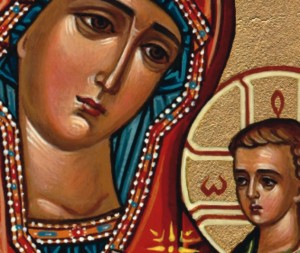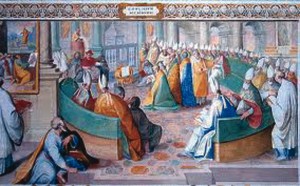Mary for Today
At the Council: At Vatican II two patterns of approach to Mary came into conflict, and the first millennium won as the pattern for the third Christian millennium. Let us examine the two in more detail. Of the 2,500 bishops at the Council, 600 asked for a specific statement from the Council on Mary, 400 wanted a new title or role defined. A document had been prepared and sent out, built on all the old (the second millennium) principles and teachings. 100 bishops asked that the Council say nothing on Mary; the rest were silent on the topic. By a narrow majority, 1,114 to 1,074 the first draft document that had been sent out was rejected. A new text had to be produced, to incorporate the significant changes and content emerging at that time. The final text kept only 14 of the 117 papal quotations of the original draft and greatly increased the biblical references.
Gospel Portraits: The New Testament stories of Mary form the primary source for all later interpretation, whether we see her with the family on the outside of discipleship as in Mark (3:31-35), in the genealogy of Jewish and Gentile ancestry as in Matthew (1:1-17), or as the Spirit-filled woman of faith as Luke presents her (1:35), or symbolising her at Cana and the cross as in John (2:1-12; 19:25-27). The earliest liturgical formulations (still with us today in the First Eucharistic prayer) place Mary with the saints in heaven, when we pray in union with Mary, Joseph, her husband, apostles and martyrs, and named saints. The mother of Jesus is part of a group of God-seekers, linked through time, the Communion of Saints. Liturgical prayer places Mary in the company of believers, living and dead.
Western Church Silence: In light of what was to come, the relative silence of the first three centuries is remarkable. She was not mentioned by most theologians; there was no public, official veneration of Mary, the church celebrated feast days in honour of martyrs, which Mary was not. The main issue that was to bring Mary out of the shadows for the Western Church was a growing discussion about the identity of Jesus Christ. In that increasingly heated debate, ideas about her motherhood were used to defend first the humanity and then the divinity of the Messiah, that he was true human flesh, not just apparent humanity (Docetism). Mary’s pregnancy in history ensured the human authenticity of Jesus’ body. The first principle of any sound Mariology is that any truth about Mary is first of all a truth about her Son.
The Turning Point: The Council of Nicea (325) affirmed the divinity of Christ; Ephesus (431) affirmed that Mary was the mother of the one who is personally the Word of God. The essence of the controversy was Christological, but the Marian title of Theotokos (God-bearer) bore the brunt of the dispute. From this point on, the development of the Marian cult goes public and attention focuses on Mary in herself.
Eastern and Western Christianity differed during these centuries. The eastern, Greek-speaking church was marked by fervent, enthusiastic reflection and imaginative interest in Mary. The western, Latin-speaking church, by contrast, displayed a restraint rather more parallel to the gospels and earliest eastern theologians. When the Marian creations of the East arrived in the West, they quickly took root and flourished. But in the early centuries the West did little to generate fervent, poetic ardour, thinking instead about Mary largely in relation to the mystery of Christ and the graced life of the community.
Augustine summed up much of the approach to Mary with his comment: “It means more for her, an altogether greater blessing, to have been Christ’s disciple than to have been Christ’s mother.” Discipleship is emphasised over motherhood, and discipleship is what we are called on to share in with Mary (see Mk 3:31-35; Matt 12:46-50; Luke 8:19-21).
The Desert Fathers and Mothers: With the era of Constantine and the tolerance of Christianity, martyrdom gave place to asceticism as the ideal, and Mary, Queen of Virgins, became patroness of ascetics and celibates. In this changed view of the Christian life, Mary appears in a new light. In an important document of that time, The Proverbs of the Council of Nicea (A.D. 325), we find a most extraordinary picture of Mary that projects onto her all the ideals of what at that time a nun was thought to be. “Mary never saw the face of a strange man; that was why she was confused when she heard the voice of the angel Gabriel. She did not eat to feed her body, but she ate because of the necessity of her nature. She withdrew all by herself into her house, being served by her own mother. She sat always with her face turned towards the East, because she prayed continually. Her brothers wanted to see her and speak to her. And she did not receive them. She slept only according to the need of sleep. When she put on a garment she used to shut her eyes. She did not know many things of this life, because she remained far from the company of women. If therefore, a girl wants to be called a virgin, she should resemble Mary.”
We may smile at this portrait and dismiss it as the product of a pious eccentric whose fevered imagination and unbounded admiration of Mary led him to ignore the clear testimony of the Gospels, notably the Visitation by Mary to her cousin Elizabeth, that certainly do not present her as a pious recluse. But in fact The Proverbs of Nicea was an authoritative document and the portrait it gives was by no means a fanciful exception to the common view of Mary. Christians of that time did tend to think of her in those terms.
Popular Piety: Of course popular piety, then as now, was hugely influential. This often takes its own course and draws theology after it. This is the case with devotion to Mary. In the West, Mary was situated within scripture and liturgy, in the midst of the community rather than above it. This era is called ‘objective’, not requiring enthusiastic personal devotion to Mary, but honouring her among many notable models of faith including the apostles and martyrs. A quite different mood takes over in the second millennium, when a more ‘subjective’, emotional type of relationship increasingly glorifies Mary in her own right, especially her ability to obtain and dispense mercy.
References: Elizabeth Johnson; Kathleen Coyle.



 Entries(RSS)
Entries(RSS)